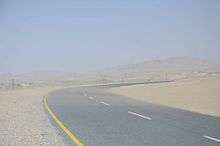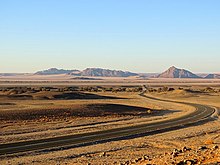Transport in Namibia
This article deals with the system of transport in Namibia, both public and private.
General
History
The beginnings of organised travel and transport routes in the territory of South West Africa, today Namibia, have not yet been established. This is due to the lack of any written records relating to roads prior to the twilight of the 19th century.[1] Archaeological work has dated one stretch of road in the south-western Brandberg Massif to c. 1250 AD. Although no other such early examples have been found, it is certain that this road was not the only one of its kind.[2]
The first permanent road, established for ox wagons, was built at the initiative of Heinrich Schmelen, Rhenish missionary in Bethanie in the early 19th century. It led from Bethanie to Angra Pequeña, today the town of Lüderitz, and was intended to serve the natural harbour there in order to become independent of the Cape Colony.[2]
Road



Namibia's road network is regarded as one of the best on the continent; road construction and maintenance adheres to international standards.[3] The countrys 48,875.27 km roads (2017) are administered by the Roads Authority, a state-owned enterprise established by Act #17 of 1999. Due to low traffic volumes the majority of roads are not tarred. The distribution of road surfaces is:[4]
- 6,664 kilometres (4,141 mi) standard bitumen road
- 412 kilometres (256 mi) low-volume bitumen road. These roads have the same base layer as gravel roads but are covered with a thin layer of bitumen to reduce maintenance cost and dust formation.
- 25,710 kilometres (15,980 mi) standard gravel road, covered with imported gravel.
- 11,460 kilometres (7,120 mi) earth-graded road. These roads are built by clearing the vegetation and blading the surface. Compaction is achieved by the traffic using the road. Some of these roads are not graded at all but just consist of earth or sand tracks separated by vegetation. These tracks are in use where a daily usage of less than five vehicles is expected.
- 288 kilometres (179 mi) salt road. These roads consist of concentrated salt water and gypsum-rich material. They are only built near the Atlantic coast inside the mist belt.
Roads by region (2017)
| Region | Bitumen (km) |
Gravel (km) |
Salt (km) |
Earth (km) |
Others (km) |
Total (km) |
Kilometers per 1000 km² |
|---|---|---|---|---|---|---|---|
| Erongo | 466.9 | 1748.3 | 269.9 | 1025.7 | 14.2 | 3524.98 | 55.5 |
| Hardap | 654.7 | 4566.4 | 0,0 | 1358.9 | 0.0 | 6597.95 | 59.9 |
| Karas | 1314.7 | 4989.0 | 5.0 | 1347.9 | 2.1 | 7658.62 | 47.6 |
| Kavango East | 344.4 | 465.9 | 0.0 | 673.2 | 82.5 | 1656.95 | 64.7 |
| Kavango West | 428.0 | 218.8 | 0.0 | 629.3 | 24.3 | 1300.41 | 56.0 |
| Khomas | 361.8 | 1729.0 | 0.0 | 666.2 | 70.9 | 2827.85 | 76.8 |
| Kunene | 515.5 | 2644.1 | 25.0 | 1524.5 | 186.6 | 4895.68 | 33.9 |
| Ohangwena | 359.2 | 316.9 | 0.0 | 350.2 | 303.5 | 1329.71 | 125.4 |
| Omaheke | 445.4 | 2974.1 | 0.0 | 2055.0 | 33.6 | 5508.09 | 73.8 |
| Omusati | 726.4 | 486.8 | 0.0 | 750.6 | 261.8 | 2225.58 | 163.2 |
| Oshana | 129.2 | 261.7 | 0.0 | 178.2 | 182.6 | 751.78 | 141.8 |
| Oshikoto | 513.3 | 934.2 | 0.0 | 328.9 | 12.6 | 1789.06 | 67.3 |
| Otjozondjupa | 1137.6 | 4454.0 | 0.0 | 1702.6 | 66.1 | 7360.35 | 69.9 |
| Zambezi | 504.7 | 257.4 | 0.0 | 697.4 | 79.8 | 1539.26 | 78.8 |
The major highways in Namibia are as follows:







- A 4-kilometre (2.5 mi) spur section, also desginated B8, runs between Katima Mulilo and the Katima Mulilo Bridge (Zambian border).




Road accidents
2018 there were about 393,062 cars registered in Namibia (169,911 in the capital Windhoek).[5] Namibia has a relatively high prevalence of road accidents, compared to its sparse population. In 2011, 491 people died in 2,846 crashes.[6] Causes are often speeding and reckless driving, as well as general non-observance of traffic rules.[7] Stray animals are also a major cause of accidents, particularly in the Kavango Region.[8]
Railway
Rail transport in Namibia is operated on a 2,687-kilometre network by TransNamib.


Railway links to adjacent countries
- Angola - There is currently no rail connection to Angola, although an agreement has been signed for link. Angola uses the same gauge,1,067 mm (3 ft 6 in), as Namibia.[9] (Rail transport in Angola)
- Botswana - There is currently no rail-link with Botswana, though the two countries use the same gauge. As of February 2011, construction on a Trans-Kalahari rail link between Botswanan coal fields and Walvis Bay was expected to begin in a year and a half.[10] (Rail transport in Botswana)
- South Africa - There is a rail connection to South Africa; the two countries use the same 1,067 mm (3 ft 6 in) gauge. (Rail transport in South Africa)
- Zambia - There is currently no rail-link with Zambia, though the two countries use the same gauge. As of February 2011, there has been some talk of extending rail to the Zambian border.[11] (Rail transport in Zambia)
Timeline
2007
- December - Progress [13]
- 26 October - Talks between Namibia and Angola regarding a link between Namibia and Chamutete in Angola.
- 18 October - According to an Engineering News report, a 700 km extension of the Grootfontein branch is planned, to Katima Mulilo on the Zambian border. A feasibility study by March 2008. Walvis Bay Corridor Group says "Our focus is on trade facilitation through a cheaper and faster route. We are targeting the copper mines in Zambia. Katima Mulilo is about 130 km from the nearest railway in Zambia as the crow flies, once the Zambesi has been bridged. The lightly laid Mulobezi branch from Livingstone ( 80 km or so ) would need upgrading, although a shorter and straighter route might be considered.
2008
- Proposed electrified line through Kalahari Desert to Palapye in Botswana.
Ports and harbours
Atlantic Ocean
Merchant marine
none (2002, 1999 est.)
Airports
Windhoek Hosea Kutako International Airport is the main international airport in the country. Two others international airports are Walvis Bay Airport and Eros Airport in Windhoek.
|
| ||||||||||||||||||||||||||||||||||||||||
See also
- Namibia
- TransNamib
- Namibian Airports - History, data, airlines, parking, car rental, photos, planespotting,...
References
Notes
- Dierks 2001, chapter 1 - Introduction to the History of Roads in Namibia.
- Dierks 2001, Chapter 2.1 - The Pre-historic era circa 1250 - circa 1770.
- Heita, Desie (27 July 2011). "RA needs over N$1 billion". New Era. Archived from the original on 9 May 2012. Retrieved 27 July 2011.
- "Get to know Namibia's National Road Network". supplement to several Namibian newspapers. Namibia Roads Authority. March 2012.
- Crash and Claims Reports 2018. Motor Vehicle Accident Fund, 2018, p. 46.
- Smith, Jana-Mari (3 January 2012). "Road accidents claim 60 lives". The Namibian.
- Khobetsi, Lorato (2011). "Road accidents claim more lives". Namibia Economist. Archived from the original on 17 October 2015. Retrieved 27 November 2012.
- Matali, Mutonga. "Stray animals major cause of accidents". New Era. Archived from the original on 2012-05-27. Retrieved 27 November 2012.
- Gauge
- BusinessLive, retrieved February 17, 2011
- TransKalahari Railway to steam ahead in 2012, retrieved February 17, 2011
- March News
- The Namibia Economist - Northern railway extension now on track Archived 2012-02-08 at the Wayback Machine
Literature
- Dierks, Klaus (2001). Namibian Roads in History from the 13th Century till Today. Institut für Wirtschafts- und Sozialgeographie, Johann Wolfgang Goethe-Universität Frankfurt/Main.CS1 maint: ref=harv (link)